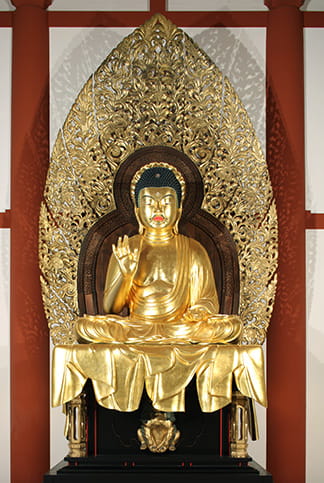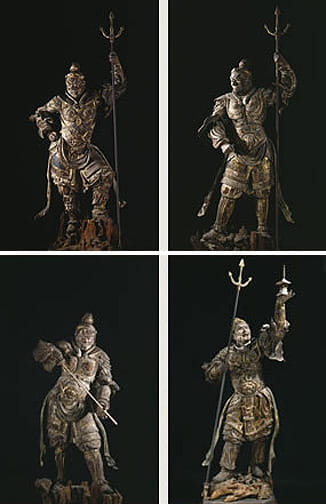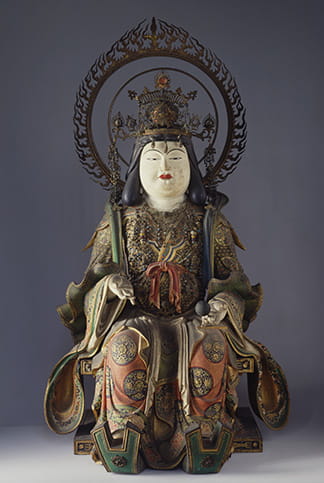Central Golden Hall
Shaka Nyorai

This splendid golden statue depicts the founder of Buddhism, Shaka Nyorai (Skt. Śākyamuni), a historical figure who attained awakening and vowed to save sentient beings in north-eastern India in the fifth century BC. The right hand is lifted with the palm toward the viewer in the dispelling-fear gesture (semui-in) while the left rests on its lap forming the gesture of granting wishes (yogan-in). Together, these hand gestures represent the great compassion of the Buddha, who dispels fear and bestows tranquility of mind upon all sentient beings.
The image is dated to 1811, and is the fourth replacement of the original icon of the Central Golden Hall, which was dedicated in 645. Carved of wood blocks that were then assembled, lacquered and gilded, this sculpture serves as both the central icon of the Central Golden Hall and the principal image of the Kohfukuji Temple complex as a whole. Although of comparatively recent construction, it faithfully reproduces the style and scale of its predecessors, and harmonizes with the images surrounding it in a way that is entirely appropriate for a temple as venerable as Kohfukuji.
Four Heavenly Kings (National Treasures)

The Four Heavenly Kings are guardian deities who protect the four sides of Mount Sumeru, the mountain that stands at the center of our “world-system” according to Buddhist cosmology. Jikokuten protects the east, Zōchōten the south, Kōmokuten the west, and Tamonten the north.
All four images portray fierce warriors who wear shoes and armor, and stand on rocky outcrops. Jikokuten and Zōchōten twist their hips to the right, while Kōmokuten and Tamonten twist their hips to the left. Jikokuten holds a sword in his right hand with the blade resting on his right, Zōchōten grasps a trident in his left hand with his right balled into a fist on his hip, Kōmokuten holds a trident in his left hand with his right balled into a fist in front of his body, and Tamonten grasps a trident in his right hand and a miniature stūpa in his right.
Made of joined blocks of wood covered in paint and gold leaf, the images are highly realistic and exquisitely detailed. Their dramatic gestures and aura of latent power make them brilliant examples of the sculptures created during the reconstruction of Kohfukuji in the early Kamakura Period (1185–1333).
Kisshōten (Important Cultural Property) Central Golden Hall

A deity of beauty, prosperity and wealth, Kisshōten represents an incorporation of Lakṣmī, the Indian goddess of beauty and good fortune, into the Buddhist pantheon. According to an inscription on its pedestal, this statue was carved in 1340 by the sculptor Kankei. A secret image, it was originally enshrined in the Central Golden Hall behind the central altar with its back to the back of the principal icon. Until the destruction of the Central Golden Hall in 1717, the image served as the principal icon for the Kisshōe (Lakṣmī Rite) held at the beginning of the first month to pray for peace and prosperity in the New Year.
Kisshōten is portrayed seated on a throne wearing a colorful wide-sleeved robe and elaborate jeweled crown. She holds a wish-fulfilling jewel in her left palm, while the right hand is extended out with the palm facing upward in what appears to be the gesture of granting wishes (yogan-in). Enshrined inside the statue are maṇḍalas of seed syllables (Skt. bīja) drawn with ink on paper, as well as sets of the five grains and five precious objects. The inside panels of the doors of the shrine feature paintings of the Indian deities Bonten (Skt. Brahmā) and Taishakuten (Indra), while the back panel is covered by a painting of a white elephant that rides on a cloud above a mountain landscape and scatters wish-fulfilling jewels from a vessel held in its trunk. The doors of the shrine are currently opened only on the first seven days of the year.

